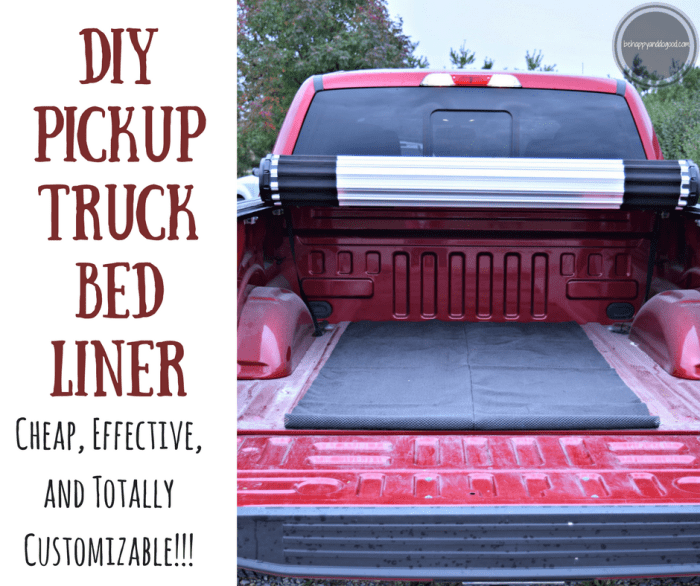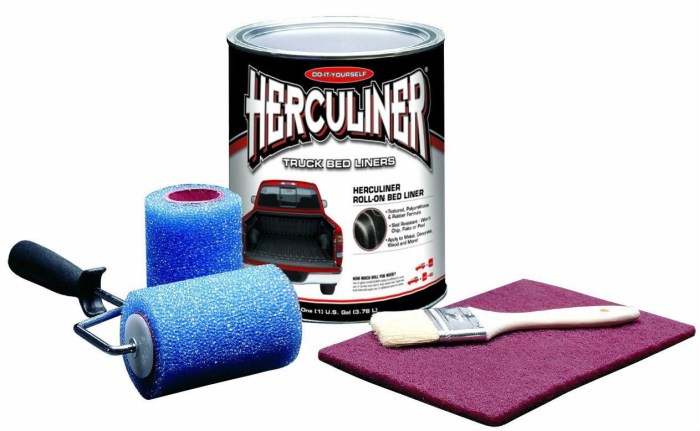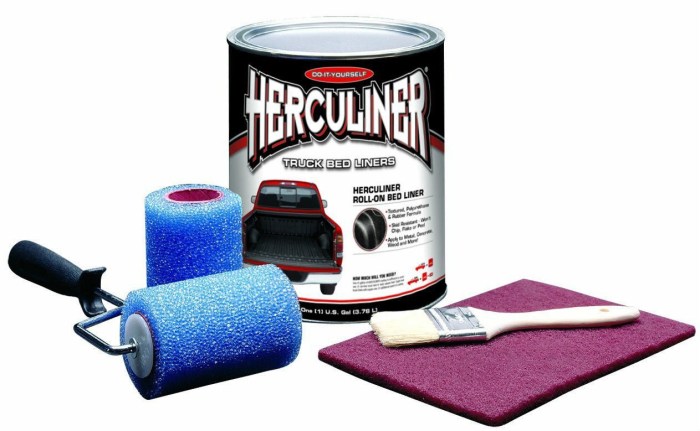DIY truck bed liner offers a cost-effective and personalized way to protect your truck bed from scratches, dents, and wear and tear. Whether you’re hauling heavy loads, transporting gear for outdoor adventures, or simply want to enhance your truck’s aesthetics, applying a bed liner yourself can be a rewarding project.
This guide will walk you through the entire process, from choosing the right materials and tools to applying the liner and ensuring proper curing. We’ll cover everything you need to know to achieve a durable and professional-looking finish.
DIY Truck Bed Liner
A truck bed liner is a protective coating applied to the bed of a pickup truck to safeguard it from scratches, dents, and corrosion. It’s a crucial investment for anyone who uses their truck for hauling, transporting, or general work, as it helps maintain the bed’s functionality and aesthetic appeal.
DIY truck bed liner application offers several advantages, including cost savings, greater control over the application process, and the ability to personalize the look of your truck bed. It’s a rewarding project that can be tackled by anyone with basic DIY skills and a bit of patience.
Types of DIY Truck Bed Liners
The availability of various DIY truck bed liner options caters to different needs and preferences. Understanding the distinct features of each type can help you choose the most suitable one for your truck.
- Spray-on bed liners: These liners are typically applied using a spray gun and offer a durable, seamless finish. They are available in a variety of colors and textures, allowing for customization.
- Drop-in bed liners: These liners are pre-molded and simply drop into the truck bed, offering a quick and easy installation process. They are available in a variety of materials, including rubber, plastic, and carpet.
- Roll-on bed liners: These liners are applied using a roller and provide a textured, non-slip surface. They are a more budget-friendly option compared to spray-on liners and are available in a variety of colors.
Materials and Tools
Preparing for your DIY truck bed liner project involves gathering the necessary materials and tools. Having the right supplies will ensure a smooth and successful application process.
Materials
The materials you’ll need for your DIY truck bed liner project depend on the type of liner you choose. Common options include spray-on bed liners, drop-in liners, and roll-on liners.
- Spray-on bed liner: This type of liner is applied using a spray gun and typically requires a compressor. You’ll need a suitable spray-on bed liner product, a compressor, a spray gun, and appropriate safety gear, such as a respirator mask, gloves, and eye protection.
- Drop-in bed liner: These liners are pre-molded and simply drop into your truck bed. You’ll need a drop-in bed liner kit that fits your specific truck model. Some kits may include additional materials like adhesive or fasteners.
- Roll-on bed liner: This type of liner is applied using a roller and requires a suitable roll-on bed liner product, a roller, and a paint tray.
Tools
The tools you’ll need for your DIY truck bed liner project will vary depending on the type of liner you choose. However, some common tools include:
- Cleaning supplies: You’ll need a degreaser, soap, and water to clean the truck bed before applying the liner.
- Sandpaper: Sandpaper is used to roughen up the surface of the truck bed, ensuring proper adhesion of the liner.
- Masking tape: Masking tape is used to protect areas of the truck bed that you don’t want to be coated with the liner.
- Paint scraper: A paint scraper is used to remove any loose paint or debris from the truck bed surface.
- Level: A level is used to ensure that the liner is applied evenly.
- Roller: A roller is used to apply roll-on bed liner products.
- Spray gun: A spray gun is used to apply spray-on bed liner products.
- Compressor: A compressor is needed to power a spray gun for spray-on bed liner applications.
- Safety gear: This includes a respirator mask, gloves, and eye protection to protect you from harmful chemicals and dust.
Choosing the Right Materials and Tools
- Type of liner: Consider the type of liner that best suits your needs and budget. Spray-on bed liners offer a durable and customizable finish, while drop-in liners are easier to install and offer good protection. Roll-on bed liners are a more affordable option but may not be as durable as other types.
- Quality of materials: Choose high-quality materials to ensure a durable and long-lasting bed liner. Look for products that are specifically designed for truck bed applications and have good reviews.
- Tools: Select tools that are appropriate for the type of liner you choose. If you’re using a spray-on bed liner, make sure you have a compressor and a spray gun that are compatible with the product. For roll-on bed liners, choose a roller with a nap length that’s suitable for the liner’s viscosity.
Preparation
Proper preparation is essential for a successful DIY truck bed liner application. A clean and well-prepared surface ensures the liner adheres properly and provides long-lasting protection.
Cleaning and Degreasing
Thoroughly cleaning and degreasing the truck bed is crucial for optimal adhesion.
- Start by removing any loose debris, dirt, or rust using a stiff brush, scraper, or pressure washer.
- Use a degreaser specifically designed for automotive applications to remove oil, grease, and other contaminants. Follow the product’s instructions for application and dwell time.
- After degreasing, rinse the truck bed thoroughly with clean water to remove all residue. Allow the surface to dry completely before proceeding.
Masking Off Surrounding Areas
Protecting surrounding areas from accidental liner application is essential.
- Use painter’s tape to mask off any areas you don’t want to be coated, such as the tailgate, wheel wells, and any other sensitive parts.
- Apply the tape carefully, ensuring a tight seal to prevent liner from seeping underneath.
- Consider using a drop cloth or plastic sheeting to protect the ground and surrounding areas from spills or overspray.
Application Process

Applying the DIY truck bed liner is a straightforward process that requires patience and attention to detail. Follow these steps to ensure a professional-looking and durable finish.
Applying the Liner
Before applying the liner, it’s essential to ensure the truck bed is clean, dry, and free from any debris. The surface should also be free of rust, grease, and oil. Once the bed is prepared, you can begin applying the liner.
- Pour the liner into a tray or bucket. This will make it easier to control the application.
- Dip a brush, roller, or sprayer into the liner. The type of applicator you choose will depend on the size of your truck bed and your personal preference.
- Apply the liner in thin, even coats. The liner should be applied in a consistent direction, such as up and down or side to side.
- Work in small sections. This will help to prevent the liner from drying too quickly.
- Use a brush or roller to smooth out the liner. Ensure that the liner is spread evenly and there are no drips or runs.
- Allow the liner to dry completely. The drying time will vary depending on the type of liner and the temperature.
Preventing Drips and Runs, Diy truck bed liner
One of the most common mistakes when applying DIY truck bed liner is creating drips and runs. To prevent this, follow these tips:
- Apply the liner in thin coats. Avoid applying too much liner at once, as this will increase the risk of drips and runs.
- Use a brush or roller to smooth out the liner. This will help to ensure that the liner is spread evenly and there are no drips or runs.
- Work in small sections. This will give you more control over the application and reduce the risk of drips and runs.
- Allow the liner to dry completely. Don’t try to speed up the drying process by using a hairdryer or other heat source, as this can cause the liner to bubble or crack.
Drying and Curing
The drying and curing process is a crucial step in achieving a durable and long-lasting DIY truck bed liner. It allows the liner to harden properly, ensuring its resistance to wear and tear.
The drying and curing time for a DIY truck bed liner can vary depending on the type of liner used, the temperature, and the humidity. However, most DIY truck bed liners require at least 24 hours to dry completely, and a full cure can take up to 72 hours.
DIY truck bed liners are a great way to protect your truck bed from scratches, dents, and other damage. You can find a variety of DIY truck bed liner kits available online, but if you’re looking for a more natural option, you can try making your own using ingredients like linseed oil and beeswax. The process is similar to making DIY sun tanning oil , except you’ll be using different ingredients and applying it to your truck bed instead of your skin.
Once you’ve applied the DIY truck bed liner, you’ll need to let it dry completely before using your truck bed.
Drying and Curing Time
The drying and curing time for a DIY truck bed liner is crucial for achieving a durable and long-lasting finish. The drying time refers to the time it takes for the liner to become touch-dry, while the curing time refers to the time it takes for the liner to fully harden and reach its maximum strength.
- Drying Time: This typically takes 24 hours, allowing the liner to become touch-dry.
- Curing Time: The full curing process can take up to 72 hours, ensuring the liner reaches its maximum strength and durability.
Importance of Sufficient Drying Time
Allowing sufficient drying time is essential for several reasons:
- Preventing Cracking: Insufficient drying time can lead to cracking and peeling of the liner, especially in areas exposed to direct sunlight or high temperatures.
- Ensuring Proper Adhesion: Proper drying time allows the liner to adhere firmly to the truck bed surface, preventing it from lifting or coming loose.
- Maximizing Durability: A fully cured liner provides superior protection against scratches, dents, and other forms of damage.
Protecting the Liner During Curing
Protecting the liner during the curing process is important to prevent dust, debris, and other contaminants from sticking to the surface. This helps ensure a smooth and durable finish.
- Covering the Liner: Use a tarp or drop cloth to cover the liner and protect it from dust, debris, and rain.
- Avoid Direct Sunlight: Direct sunlight can accelerate the drying process and potentially lead to cracking. It is best to cure the liner in a shaded area.
- Minimize Traffic: Avoid driving on the liner during the curing process to prevent damage or footprints.
Maintenance and Care: Diy Truck Bed Liner
Proper maintenance is crucial for extending the life of your DIY truck bed liner and keeping it looking its best. With a few simple steps, you can ensure your liner stays durable and protects your truck bed for years to come.
Cleaning Methods and Recommended Products
Regular cleaning is essential to remove dirt, debris, and grime that can accumulate on the liner’s surface.
- For routine cleaning, use a mild soap and water solution. Avoid harsh chemicals or abrasive cleaners, as these can damage the liner’s surface.
- For tougher stains or buildup, a pressure washer can be effective. Be sure to use a low-pressure setting and avoid spraying directly at seams or joints to prevent damage.
- For stubborn stains, a specialized cleaner designed for truck bed liners can be used. Follow the manufacturer’s instructions carefully.
Preventing Damage and Wear
Here are some tips for preventing damage and wear to your DIY truck bed liner:
- Avoid dragging heavy objects across the liner. This can cause scratches and gouges.
- Use a bed mat or cover when transporting items that might damage the liner.
- Inspect the liner regularly for signs of damage and repair any issues promptly.
Common Mistakes to Avoid

Applying a DIY truck bed liner can seem simple, but even small mistakes can lead to a less-than-perfect finish. Knowing common pitfalls and how to avoid them can save you time and effort in the long run. Here are some common mistakes to avoid when applying a DIY truck bed liner:
Inadequate Preparation
- Insufficient Cleaning: A clean surface is crucial for proper adhesion. Dirt, debris, and even a thin layer of grease can prevent the liner from bonding effectively, resulting in peeling or chipping over time. Thoroughly clean the truck bed with a degreaser and pressure washer to remove all contaminants.
- Skipping the Primer: While not always required, a primer can improve adhesion and prevent the liner from reacting with the metal. Check the manufacturer’s instructions to see if a primer is recommended for your specific liner.
Application Errors
- Uneven Coating: Applying the liner too thinly in some areas or too thickly in others can lead to an uneven finish. Use a roller or brush with consistent pressure and apply thin, even coats.
- Overlapping Too Much: Overlapping coats too much can create a thick, uneven surface that may not cure properly. Allow each coat to dry completely before applying the next one.
- Not Using a Mask: Not wearing a mask during application can lead to inhaling harmful fumes. Always wear a respirator to protect yourself from the liner’s chemicals.
Curing Issues
- Ignoring Curing Time: Each liner has a specific curing time, usually 24-72 hours, needed for it to fully harden. Driving or using the truck bed before it’s cured can damage the liner and result in peeling.
- Exposing to Extreme Temperatures: Exposure to extreme heat or cold during the curing process can affect the liner’s performance. If possible, cure the liner in a shaded, temperature-controlled environment.
Troubleshooting
- Peeling: If the liner starts to peel, it’s likely due to improper preparation or curing. Remove the loose liner and reapply it after properly cleaning and preparing the surface.
- Uneven Finish: If the finish is uneven, try sanding down the high spots and reapplying a thin layer of liner.
- Bubbles: Bubbles can occur if the liner is applied too thickly or if air is trapped during application. Use a roller or brush with consistent pressure and apply thin, even coats.
With a little patience and attention to detail, you can easily apply a DIY truck bed liner that will provide years of protection and enhance the functionality of your truck bed. Remember to prioritize safety, follow the instructions carefully, and enjoy the satisfaction of completing this DIY project.

